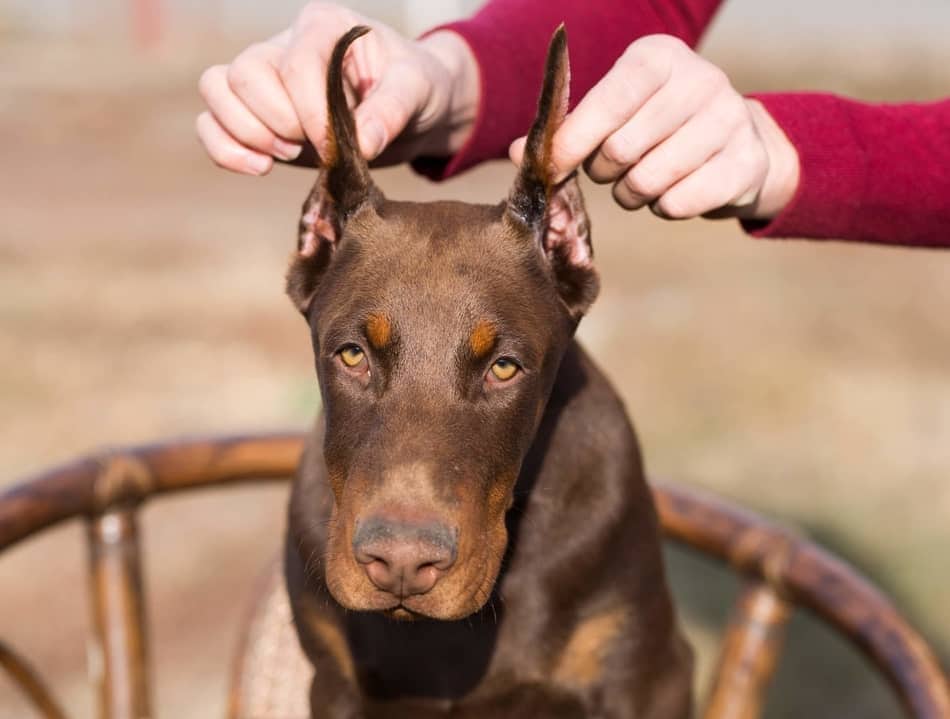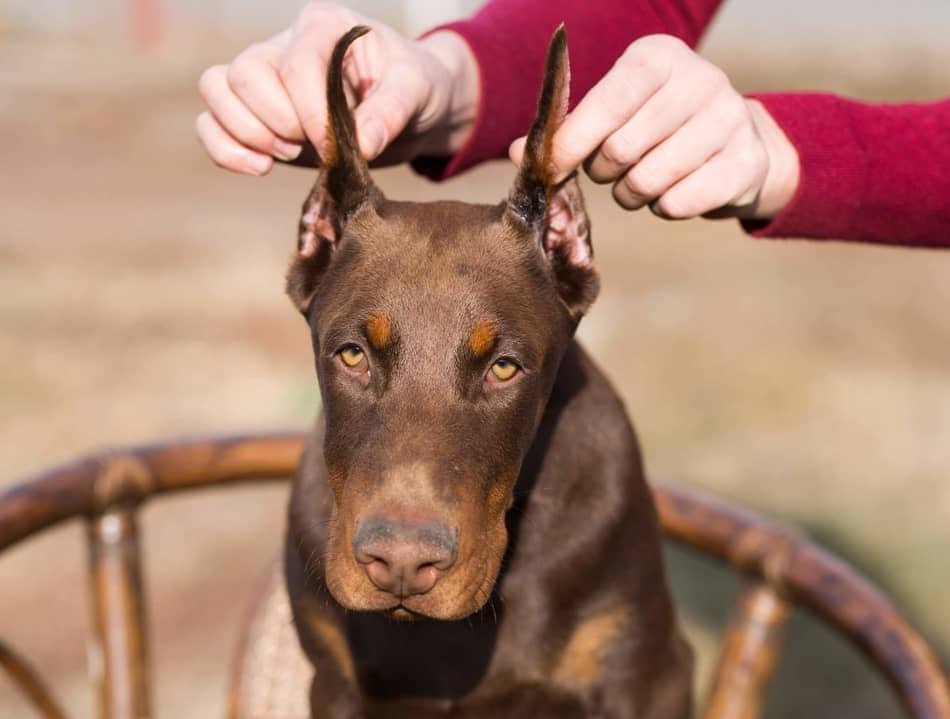When it comes to deciding when to crop Doberman ears, there are several factors to consider. One important aspect is the history of ear cropping in the breed. Ear cropping has been a longstanding tradition in Dobermans, dating back to the late 19th century. The purpose behind it was originally to enhance the dog’s appearance and provide a more alert and imposing look. However, opinions on ear cropping have evolved over time, and now it is a personal decision for dog owners based on both aesthetics and practical considerations.
The decision to crop a Doberman’s ears should be made in consultation with a professional veterinarian. It is typically recommended to have the procedure done when the puppy is between 7 and 12 weeks old. This age range is considered optimal because the puppy’s ears are still soft and malleable, which makes the healing process easier and reduces the risk of complications. Additionally, younger puppies tend to adapt to the procedure more quickly and have better cosmetic results. However, it is important to note that each dog is unique, and the ultimate decision should be based on what is best for the individual Doberman and in accordance with local laws and regulations.
Deciding when to crop Doberman ears is a personal choice. It is typically done when the puppy is between 7 and 12 weeks old. This allows the ears to heal properly while the cartilage is still soft. It’s important to consult with a professional veterinarian who can assess your dog’s health and determine the best age for ear cropping. Remember to consider your local laws and regulations regarding cosmetic surgeries for pets before making a decision.

When to Crop Doberman Ears?
Doberman ears are known for their characteristic look when cropped. However, deciding when to crop a Doberman’s ears is a complex decision that requires careful consideration. The timing of the procedure can impact the health and appearance of the dog. In this article, we will explore the factors to consider when determining the optimal time to crop a Doberman’s ears.
6-8 Weeks Old: Ideal Window for Ear Cropping
The ideal time to crop a Doberman’s ears is between 6 and 8 weeks of age. This window provides a perfect balance between allowing the ears to fully develop and ensuring optimal healing of the surgical incisions. During this period, a Doberman puppy’s ears are still soft and malleable, making it easier for the veterinarian to shape them according to the desired look.
It is crucial to find an experienced veterinarian who specializes in ear cropping to perform the procedure. They will have the necessary skills and knowledge to achieve the desired outcome while prioritizing the health and well-being of the dog. Additionally, the incisions and sutures must be carefully monitored and cared for during the healing process to prevent infection and ensure proper healing.
Ear cropping is an elective cosmetic procedure, and the decision to proceed with it should be made with careful consideration of the breed standard, personal preference, and the dog’s overall health. It is essential to consult with a reputable veterinarian who can guide you through the process and address any concerns or questions you may have.
Benefits of Cropping Doberman Ears at a Young Age
There are several benefits to cropping a Doberman’s ears at a young age:
- Ear cartilage is soft and pliable, allowing for easier molding and shaping.
- Young puppies heal faster and have a higher tolerance for pain.
- Ears that are cropped at a young age have a better chance of standing upright.
- The puppy will adapt to the new ear shape more easily as it grows.
By cropping the ears at a young age, the dog has an increased likelihood of achieving the desired ear shape and standing posture. It is important to note that individual results may vary, and not all cropped ears will stand erect.
Ethical Considerations of Ear Cropping
There are ongoing debates about the ethical implications of ear cropping in dogs. Some argue that it is an unnecessary and painful procedure performed solely for cosmetic reasons. Others believe that it is a personal choice based on breed standards and aesthetic preferences.
It is important to approach this topic with an open mind and consider the well-being of the dog above all else. The decision to crop a Doberman’s ears should be made after thorough research, consultation with professionals, and careful thought regarding the dog’s health and overall happiness.
Alternative to Ear Cropping: Natural Ears
Some owners choose to keep their Doberman’s ears in their natural state without cropping. Natural ears can be equally beautiful and have their own unique charm. It is a personal choice that should be respected and supported.
If the decision is made to keep the Doberman’s ears natural, it is essential to regularly clean and care for them to prevent infections and maintain overall ear health.
Legal Considerations and Breed Standards
The legality of ear cropping varies across different countries and regions. Some jurisdictions have banned the procedure except for medical reasons, while others allow it as long as it is performed by a licensed veterinarian. It is important to familiarize yourself with the laws and regulations in your area before making any decisions.
Consult with a reputable veterinarian who can provide guidance on the legalities and breed standards in your area.
When to Decide Not to Crop Doberman Ears?
If you choose not to crop your Doberman’s ears, it is important to consider the following:
- Your personal preferences and aesthetic considerations.
- The breed standard and expectations in the show ring (if applicable).
- The comfort and happiness of your dog.
Ultimately, the decision to crop or not to crop a Doberman’s ears is up to the owner. It is essential to prioritize the dog’s well-being, health, and comfort above any external factors.
Key Takeaways – When to Crop Doberman Ears?
- Ear cropping is a personal decision that should be made in consultation with a veterinarian.
- It is generally recommended to crop a Doberman’s ears between the ages of 7 to 12 weeks.
- Early cropping allows the ears to heal faster and ensures better post-surgery aesthetics.
- Cropping the ears at a later stage may still be possible but can be more challenging and may result in less desirable outcomes.
- Proper aftercare is crucial to ensure the ear’s healing and to prevent complications.
Frequently Asked Questions
Here are some common questions about when to crop Doberman ears:
1. Can you explain the process of cropping Doberman ears?
The process of cropping Doberman ears involves surgically altering the shape of the ears to make them stand upright. Typically, this is done when the puppy is around 8 to 12 weeks old. The procedure is performed under general anesthesia by a veterinarian, who trims the excess ear tissue and shapes the cartilage to achieve the desired appearance.
After the surgery, the puppy’s ears are bandaged to hold them in an upright position. The bandages are usually removed after a week or two, and the ears are left to heal. It’s important to follow the aftercare instructions provided by the veterinarian to ensure proper healing and minimize the risk of infection.
2. At what age should I consider cropping my Doberman’s ears?
The ideal age to consider cropping a Doberman’s ears is between 8 to 12 weeks old. This is when the cartilage in the ears is still soft and more malleable, which allows for better shaping and positioning of the ears. It’s important to consult with a veterinarian who is experienced in ear cropping to determine the best time for the procedure.
Waiting too long to crop the ears can make the procedure more difficult and may not achieve the desired result. It’s important to note that ear cropping is a personal choice and should be done based on the owner’s preferences and in compliance with any breed standards or regulations.
3. Are there any health risks associated with cropping a Doberman’s ears?
As with any surgical procedure, there are potential risks and complications associated with cropping a Doberman’s ears. These can include infection, excessive bleeding, delayed healing, and changes in ear shape or position. It’s important to choose a reputable veterinarian who has experience in ear cropping and to follow all post-operative care instructions to minimize these risks.
It’s also important to consider that ear cropping is a cosmetic procedure and not medically necessary. Some countries and regions have banned or restricted the practice due to ethical concerns. Before deciding to crop your Doberman’s ears, it’s important to consider both the potential risks and the ethical considerations surrounding the procedure.
4. Can Doberman ears stand up naturally without cropping?
Yes, Doberman ears can stand up naturally without cropping. Some Dobermans have naturally upright ears, while others may have ears that naturally flop or fold. The decision to crop a Doberman’s ears is primarily based on personal preference and breed standards.
If you prefer the look of cropped ears or plan to show your dog in conformation events where cropped ears are required, you may choose to have the ears cropped. However, if you prefer the natural look or do not plan to enter your dog in shows that require cropped ears, then leaving the ears in their natural state is also a valid option.
5. What should I consider before deciding to crop my Doberman’s ears?
Before deciding to crop your Doberman’s ears, there are a few factors to consider:
– Personal preference: Do you prefer the look of cropped ears or natural ears?
– Breed standards: If you plan to show your Doberman in conformation events, check the breed standards to see if cropped ears are required or preferred.
– Health risks: Understand the potential risks and complications associated with ear cropping, and choose a reputable veterinarian who is experienced in the procedure.
– Ethical considerations: Consider the ethical concerns surrounding ear cropping and whether it aligns with your personal values.
By considering these factors and consulting with a veterinarian, you can make an informed decision about whether or not to crop your Doberman’s ears.

In summary, the decision to crop a Doberman’s ears should be carefully considered and discussed with a veterinarian. Ear cropping is a personal choice and may be done for cosmetic or functional reasons.
It is important to note that ear cropping should be done when the puppy is between 7 to 16 weeks old. The procedure should be performed by a trained professional to minimize pain and potential complications. Ultimately, the welfare and well-being of the dog should be the top priority when deciding whether or not to crop their ears.
